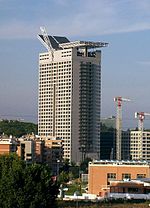Olympic Velodrome, Rome
1960 establishments in Italy1968 disestablishments in ItalyCycle racing in ItalyCycling venue stubsDefunct sports venues in Italy ... and 9 more
Italian sports venue stubsOlympic cycling venuesOlympic field hockey venuesRome Q. XXXII EuropaSports venues completed in 1960Sports venues demolished in 2008Summer Olympic venue stubsVelodromes in ItalyVenues of the 1960 Summer Olympics

The Olympic Velodrome (Italian: Velodromo Olimpico) was a sports venue located in Rome, Italy. Constructed for the 1960 Summer Olympics, it hosted the track cycling and field hockey events. The velodrome was constructed between 1957 and early 1960. Soon after it was built problems were found, as water was draining away the foundations on one side of the velodrome. Concrete was injected into the foundations, which solved the problem only temporarily. It was last used for competition in 1968, when it hosted the UCI Track Cycling World Championships. After this it was abandoned, until it was imploded on 24 July 2008.
Excerpt from the Wikipedia article Olympic Velodrome, Rome (License: CC BY-SA 3.0, Authors, Images).Olympic Velodrome, Rome
Viale dei Primati Sportivi, Rome Europa
Geographical coordinates (GPS) Address Nearby Places Show on map
Geographical coordinates (GPS)
| Latitude | Longitude |
|---|---|
| N 41.826647222222 ° | E 12.456897222222 ° |
Address
Viale dei Primati Sportivi
Viale dei Primati Sportivi
00144 Rome, Europa
Lazio, Italy
Open on Google Maps








